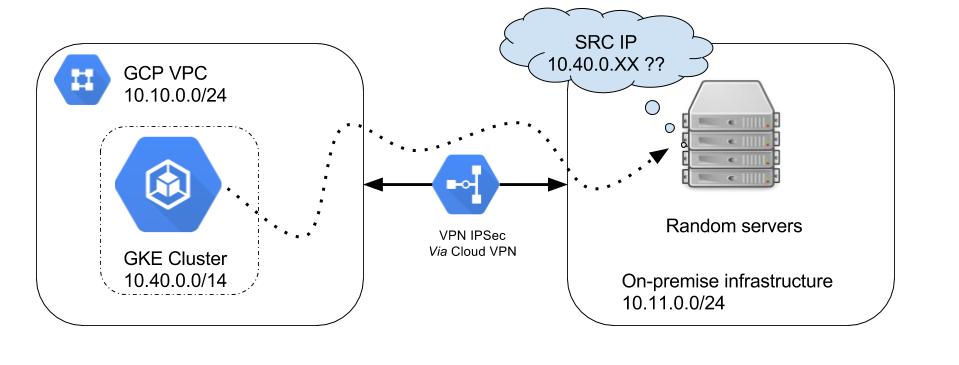Note: Since writing this post, I joined Google. We have released a feature
called IP Aliases
that addresses the problem described in this article, and much more. Activating IP Aliases requires creating a new cluster. If you can’t do that, then you can now
change the configuration of the ip-masquerade-agent as described
here.
This gives the same end-result as the solution described in this article, but
is much cleaner.
I recently ran into a problem while using Google Container Engine (GKE), the managed Kubernetes by Google. This lead me to an interesting solution that can be used for a large range of issues you could encounter in Kubernetes.
The Problem
I was unsuccessfully trying to have my pods communicate with an application available through a VPN: everything was working as expected from a VM but the pods in the GKE cluster had no network connectivity with the services on the other side of the VPN. Stranger still, when testing directly from the nodes of the cluster, everything was fine.
The Diagnostic
The fact that everything was working from the nodes of the cluster, but not the pods told me that it was probably a NAT problem. Indeed, after digging around, I discovered that the requests sent by my pods were not NATted to the IPs of the hosts they were on. This was strange because the pods had no problem accessing external resources.
This is problematic because the pods’ IPs are in a “virtual” network that exists only in the GCP environment (or only in the Kubernetes cluster if you are using a SDN provider such as Weave): the applications on the other side of the VPN do not know those IPs and have no network route to answer.

After a bit of Google-fu, I found this GitHub issue
that matched my problem. As mentioned in this link, Google uses the following
iptables configuration to allow pods to communicate with external services:
iptables -A POSTROUTING ! -d 10.0.0.0/8 \
-m comment --comment “kubenet: outbound traffic" -m addrtype \
! --dst-type LOCAL -j MASQUERADE -t nat
What does this mean? It means that traffic from the pods will be NATted to the
host IP only if the destination is not in 10.0.0.0/8.
This 10.0.0.0/8 is the problem: it’s too large. It contains both the Google
Cloud network (10.10.0.0/24) and the GKE internal network (10.40.0.0/14)
but also the network on the other side of the VPN (10.11.0.0/24)! Because
my pods were trying to communicate with services whose IPs were in the
10.11.0.0/24 range, they were not source-NATted.
The solution
The best solution I found that is not too hacky is to add a single iptables
line to the hosts:
iptables -A POSTROUTING -d 10.11.0.0/24 \
-m addrtype ! --dst-type LOCAL -j MASQUERADE -t nat
This means that the traffic that goes through the VPN will get NATted.
Automating the solution
This is the world of Kubernetes: there is no way that I am going to apply this
fix manually on all nodes, especially when using GKE! How can Kubernetes
itself be used to fix this problem? We need to apply a patch on all nodes,
current and future, of the cluster: with these specifications, a DaemonSet
seems to be the obvious solution.
If you don’t know, a DaemonSet is a Kubernetes controller that ensures that
one copy of the given pod runs at all time on all nodes of the cluster. This
is typically used for logging or monitoring.
Using this example
from the kubernetes/contrib GitHub repository, I was able to write this very
simple DaemonSet that fixes my problem permanently (in a way that I find not too
ugly).
kind: DaemonSet
apiVersion: extensions/v1beta1
metadata:
name: fix-nat
labels:
app: fix-nat
spec:
template:
metadata:
labels:
app: fix-nat
spec:
hostPID: true
containers:
- name: fix-nat
image: gcr.io/google-containers/startup-script:v1
imagePullPolicy: Always
securityContext:
privileged: true
env:
- name: STARTUP_SCRIPT
value: |
#! /bin/bash
while true; do
iptables-save | grep MASQUERADE | grep -q "NAT-VPN"
if [ $? -ne 0 ]; then
echo "Missing NAT rule for VPN, adding it"
iptables -A POSTROUTING -d 10.11.0.0/24 -m comment --comment "NAT-VPN: SNAT for outbound traffic through VPN" -m addrtype ! --dst-type LOCAL -j MASQUERADE -t nat
fi
sleep 60
done
This small script will check every minute, forever, if we have the right iptables
rule and, if not, add it.
Note that the privileged: true is necessary for the pod to be able to change
iptables rules from the host.
Conclusion
I used this method to fix a problem with the NAT configuration of GKE, but it can easily be used to automate a lot of different things on the nodes of your Kubernetes cluster. If you have ever played a little with Kargo or the Kops internals, you will know that Kubernetes can largely be used to bootstrap itself. Similarly, it can be used to fix most things in the configuration of the nodes of your cluster.
